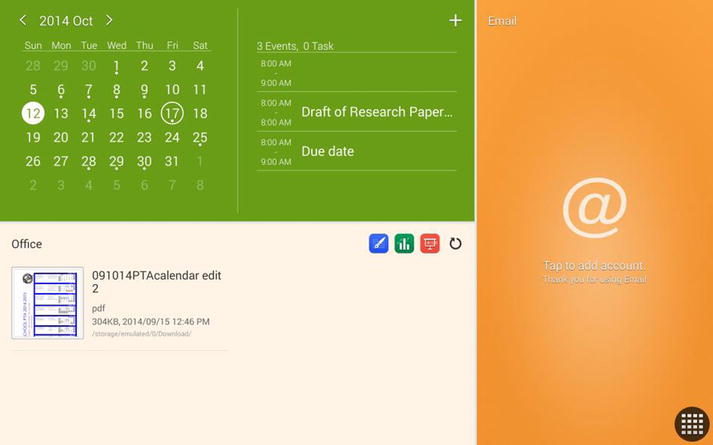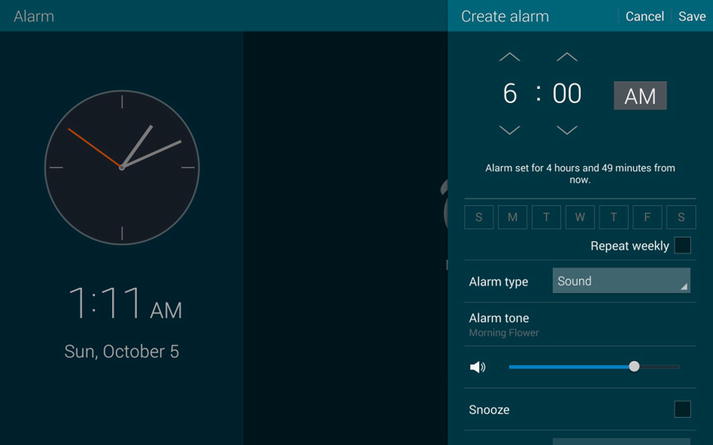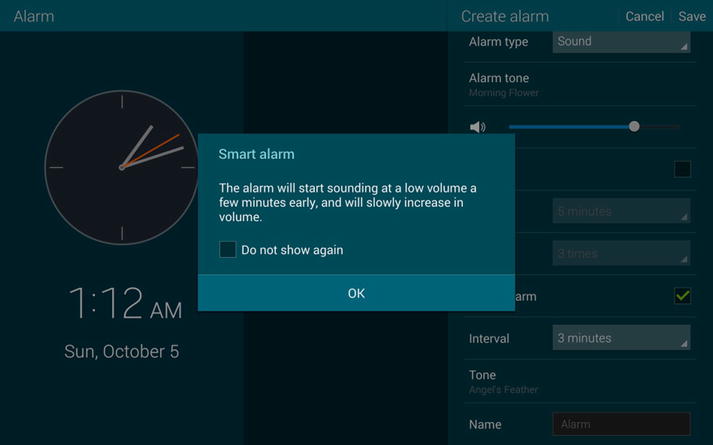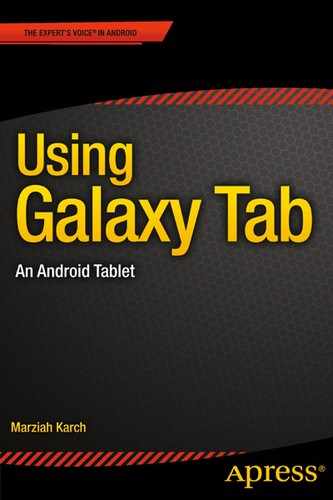Business and Pleasure
We’ve spent the last several chapters setting up your tablet and downloading all the goodies. In the last chapter we looked at ways to install apps. In this chapter, we’ll start looking at ways to use your tablet for business and pleasure. We’ll also look at ways to set up security and share your tablet with the kids.
Let’s get started by gussying up your Home screen. As you remember from Chapter 2, you have two alternative, widgetized layouts for your Home screen. There are six basic areas that can be populated by widgets that are useful to you. Let’s start with the calendar.
The Calendar
By default, the calendar syncs to your Google Calendar, but it may also sync with other calendar apps at the same time (as long as they hook into the default calendar functions on your Android tablet). That means you’re simultaneously displaying Google Calendar, “My Calendar,” your Samsung calendar, and possibly some shared calendars from Google. Figure 5-1 shows the calendar.

Figure 5-1. Calendar widget
When you first try to add an event, you’ll see an alert warning you that only “My Calendar” syncs with Samsung Kies. Samsung Kies is a desktop calendar syncing app that can run on Windows or Mac. If you’re not using it, don’t worry about this warning, and check the box saying that you don’t want to see it again.
The calendar widget is in month view on one side, and events are only displayed for the day that you have selected. By default, the current day is shown so that you can keep track of your schedule. Add an event by tapping on the plus sign.
Choose which calendar to use. If you want this event to be visible on your Google calendar for other events, select that option (Figure 5-2).

Figure 5-2. Select a calendar
Once you have selected a calendar, you’ll have a wide variety of choices to make about the event (Figure 5-3).

Figure 5-3. Choose your options
Give your event a title. You can choose a location either by entering a name or address or using the maps icon to select a location on a map. You can specify a start and stop date or designate it to be an all-day event. You can choose other attendees from your contact list, set a reminder, and more.
You may also notice that there’s a tab next to events labeled “Task.” If you tap on tasks, you can create to-do items. Note that tasks do not sync with Google Calendar. Instead, you’re stuck with your Samsung calendar or any apps you’ve installed with compatible calendars.
The thing to keep in mind here is that this is just a shortcut widget. If it is not working out for you, use the regular Google Calendar (or other app) instead. The Google Calendar app (Figure 5-4) offers many more options for viewing your calendar with views of the year, the month, the date, and “Agenda,” which just lists events in chronological order.

Figure 5-4. Google Calendar
Any events that you create on your Google Calendar will show up in any apps that sync with Google Calendar no matter where they are, so if you add an event here, it will still show up on your widget.
The Email Widget (see Figure 5-5) uses your non-Gmail email addresses, including POP, IMAP, and Exchange. That means you can check and reply to Exchange work emails right from this widget but not Gmail messages. Well, that’s not entirely true. You can check Gmail messages through POP or IMAP, but this will result in having two different apps checking the same Gmail account instead of just syncing data through a single app.

Figure 5-5. The Email widget uses the Email app, not Gmail
Note If you sign up to check your Exchange email on your tablet, you may have to sign some very uncomfortable agreements about what your workplace is authorized to do to your device, including erase it. If you don’t want to turn your device into a “company tablet,” you can get an app that segregates Exchange data from the rest of the tablet functions (this means that the email widget won’t work with it, either.) This way, if something happens, your workplace will erase just the app, not your whole tablet. My current favorite Exchange syncing app is Nine, which retails for around $10. You can use a free trial to make sure that it will sync with your Exchange account before downloading the full version.
Use the Gmail app to check and reply to Gmail messages, just as you’d use Google Calendar for calendar entries. Figure 5-6 shows the Gmail app in action.

Figure 5-6. The Gmail app
Gmail is organized into multiple subinboxes. There’s the primary inbox, for items that Google determines have been sent to you as an individual and therefore important.
Note Google is experimenting with a next generation email app called Inbox that integrates email, notes, and calendar items. If you’d like to try it out, you’ll currently need to ask someone who is already using the service for an invite.
The Office widget includes a list of recently downloaded documents that you may edit or view by tapping.
The Quick Briefing widget includes space for Bing or Yahoo bookmarks, items for the day, and stocks.
To set alarms, use the Clock app, as shown in Figure 5-7.

Figure 5-7. The clock app
Tap on the plus icon and you can add a new alarm. The Clock app allows you to set the alarm for the next day or a specific day or days of the week. You can check the box next to repeat weekly to set your standard work week alarm schedule, for example.
You can specify whether or not you’ll include the snooze button as an option.
If you scroll down a little further, you’ll see that you have the option to set a “smart alarm” (Figure 5-8).

Figure 5-8. A smart alarm
Smart alarms can be set with or without snooze.
The Samsung Galaxy Tab allows you to set several methods for locking your tablet. You can have no security at all, which is fine if you live by yourself, don’t have any personal or credit card information associated with your device, and will never ever let it out of your sight. For the rest of us, security is in order.
Go to Settings: Device: Lock Screen to set your lock screen security. The default level is Swipe, which means no security. You unlock the device by swiping anywhere. You can change to pattern, PIN, password, or—my favorite—fingerprint swipe. The first time you select this, you will need to set up your fingerprint by swiping your finger on the screen until it is calibrated (Figure 5-9).

Figure 5-9. Keep swiping until your fingerprint is calibrated
When you use fingerprint unlocking, you swipe your finger on the bottom of the screen. This works fairly well most of the time, but if you mess up too many attempts to unlock your screen, it will make you wait 30 seconds before trying again.
Adding Family Members
In Settings, select users to add more than one user for your account. This creates new profiles that won’t share data (so you don’t mix up each other’s emails or game high scores). If the account is for a child, set up a “Limited account.” Limited accounts allow you to specify exactly which apps the account can use. This way, a child can play games but not use Dropbox or email, for example.
Samsungs don’t come with Siri. That’s for iPads. You do, however, get two choices for Siri-like functions using voice commands. The first option, S-Voice, can be invoked by double-pressing on the center physical button on the bottom of your tablet. Try offering commands like “weather.” You just say the word instead of asking a question.
The second option is Google Now. Use the Google search widget and tap on the microphone. If you are already in a search, you don’t need to tap on the microphone. You can just say, “OK, Google.” Google Now uses natural phrases, so ask “What’s the weather?” and see the answer that you receive. The quality of the voice is much better for Google Now as well.
Summary
In this chapter, we explored using the tablet for work and home use.
In the next chapter, we’ll look at viewing books, movies, newspapers, and more, and we’ll show you how you can connect to other devices to get the most out of your tablet.
